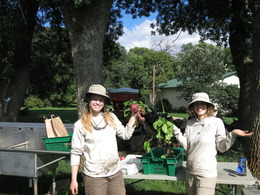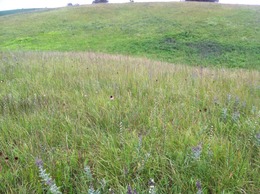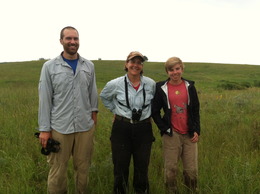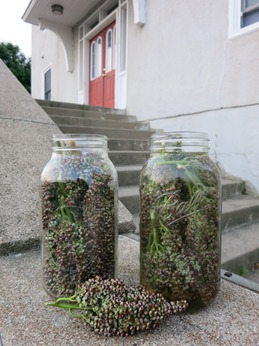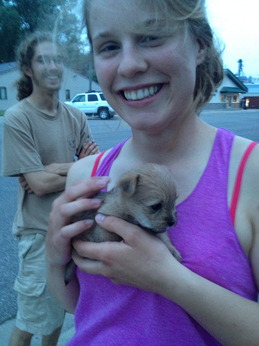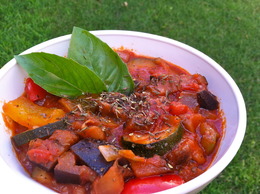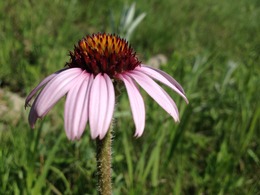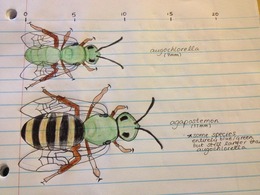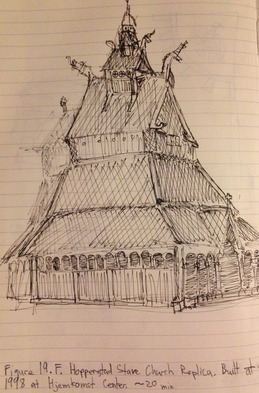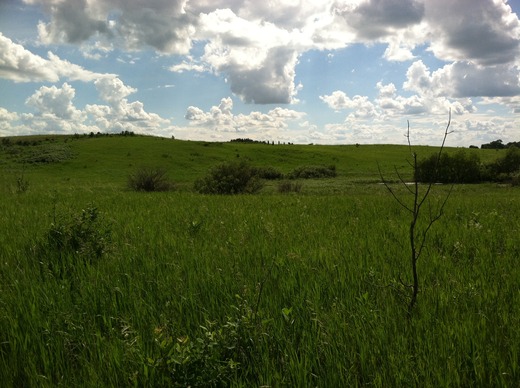|
|
As summer draws to a close, this past weekend was spent doing what anyone does at the end of growing seasons, canning and harvesting Echinacea heads.
We’ve been a part of a CSA during the end of the summer, and have been delighted by the abundance and deliciousness of the produce we have received so far. The farm, Lakeside Prairie farm (http://www.lakesideprairiefarm.com), believes in sharing the abundance of the harvest. We have been able to come out a couple times over the season and harvest whatever they have extra of as part of our CSA. This is where I got beets and green beans to can, as well as cucumbers to pickle and lots of cabbage for sauerkraut.
Pictured below, Maureen and Elizabeth enjoying the plentiful harvest at the farm.

To bring the Wagenius’s canning pot back home I retrieve it via bike, which earned me some puzzled stares from drivers on the road.

Along with canning, we’re also occupied with Echinacea head harvesting. So far we’ve done a first round of harvesting at Staffanson Prairie Preserve and a third round at P1 and P2. We see more canning and head harvesting in our near future.
-Claire
Nancy Braker and Marie Schaedel came to visit today! Nancy is the director of the Cowling Arboretum at Carleton College and Mary was a member of Team Echinacea 2013. They are also good friends of Jared’s and mine and prairie enthusiasts–so there was no disagreement about how we should spend our time.
We spent the day on a grand tour of three of the area’s largest and most diverse prairie remnants: Staffanson Prairie (right here in southwest Douglas County), Seven Sisters Prairie (near Ashby in Otter Tail County), and Strandness Prairie (Pope County). All are owned and managed by the Nature Conservancy. Every few steps we would find a new wildflower, grass, or insect to inspect, identify, and appreciate. It was a nice reminder of why we spend our days toiling in experimental plots and roadside ditches: to preserve the vibrant beauty of the healthy prairie.
Here are a few photos from our journey:
The sumac forest at Seven Sisters swallowed all but Jared’s binoculars.

In western Minnesota, a little elevation goes a long way (on top of Seven Sisters, 190 feet above Lake Christina).

Echinacea at Strandness Prairie. They look a little weird without flags and tags.

Prairie peeping makes for happy campers. (Strandness Prairie.)

While gazing up from measuring Dichanthelium today I spotted a large patch of fruiting sumac. The past summer I had been itching to make some sumac lemonade, and the abundant stand of smooth sumac (Rhus glabra) presented an irresistible opportunity!
After a quick and easy harvest of the fruits (called drupes) that are found in compound clusters at the end of branches, some team members and I returned for brewing.
There are many methods for making sumac-ade on the world wide web. The variables are sumac berries on or off the stem, the temperature of the water, and the duration of the soaking time. I decided to try out two at first, both leaving the fruits on the stem, one adding cold water and a longer wait time, and one where hot water is added and steeping only lasts 30 minutes. (Sumac is pictured below, jars thanks to Gretel and Stuart)

After many test rounds, two taste testers and I agree that the colder, longer brew time results in a more palatable, tart, and less bitter final product. The hotter, shorter method heats up the stems and causes them to release bitter sap. (In the picture below the sumac in the jar on the right was submerged in boiling water, and it is actively releasing sap).

Future projects include sumac-ade popsicles, as well as fruit drying for winter use and spice grinding.
The small town of Kensington received five new adorable puppies last week. After some sleuthing and chatting with the friendly locals, team Echinacea received the chance for some much needed puppy playtime.

But what’s more exciting than puppies? Proposals and updated procedures!
Pollinator Efficiency Proposal 2014 .doc
Pollinator Efficiency Procedure.doc
PolObDatasheet_2014.xls
Attached to this post you will find team pollinator’s original proposal as well as an updated procedure and an updated datasheet. The past three weeks have flown by and we have already conducted observations on 175 heads! This means that we are only 25 heads short of our goal just in time for the end of flowering. It is also amazing how much we have learned and how much we have had to change our procedure. I hope that someone will pick up this project next summer and this updated information will help them to avoid some of the problems we’ve encountered.
In other exciting news, tonight I cooked Ratatouille for the team. Thank you Gretel and the Wagenius garden for the delicious basil!

My favorite French dish + my favorite people = the perfect end to a relaxing Sunday.
Today Team Echinacea 2014 completed our fourth week of work. All in all it was an eventful week complete with phenological observations and an orchid adventure but fireworks still awaited us…
While the team has grown accustomed to watching sparks fly in the field (between compatible Echinacea plants of course), we were not entirely prepared for the sparks that surged forth during dinner this evening. Content with our fine meal, Team Echinacea was reveling in stimulating conversation as our refrigerator (Sparky) began to hiss, pop, and buzz before bursting into flames (only a slight embellishment of actual events). Though the electrical fire and accompanying pyrotechnic display was short-lived and the damage negligible, the smell of melting rubber lingers on.
RIP Sparky, we will miss your cold touch.
My Saturday began with some casual sketching as a way to get more familiar with some of the common pollinators found on E. angustifolia. Fun fact: illustrating correct wing venation is very arduous process.

I then joined everyone else for a team brunch at the local diner. Once all members of Team Echinacea were sufficiently stuffed with pancakes, eggs, hash browns and other belly-expanding foods, 62.5% of Team Echinacea set sail for Fargo to attend the 37th Scandinavian Hjemkomst/ Annual Midwest Viking Festival! There were battle demonstrations, informative exhibits, and plenty of Scandinavian crafts, foods, and performers. A team favorite was the Hopperstad Stave Church Replica that Cam sketched with the precision of a seasoned Viking-aficionado (Figure 19.F).

The day ended was some delicious Fettuccini Alfredo prepared by Keaton and we all fell asleep full of both food and new knowledge!
Skal! (Cheers in Norwegian from the Old Norse word for cup)
-Maureen Page
We started out the day doing what we do best: searching for seedlings in Experimental Plot 8 (a.k.a. Q2). Having braved formidable winds to plant them late last October, Stuart, Gretel, and Ruth were visibly relieved to see them pop up this spring. Since last week Team Echinacea has been diligently tracking down each seedling and “naming” them with colored toothpicks and row location coordinates, accurate to one centimeter.
In the afternoon we located and counted Echinacea in the recruitment experiment, a continuation of the project described in this paper. The procedure is really fun: we find the boundaries of the plots with metal detectors, triangulate points, then search within an area exactly the size of a regulation 175-gram Disc-craft Ultra Star disc (a.k.a. frisbee). Go CUT!
The best part of the day was tagging my first Echinacea. Maybe it just lost its old tag, but I like to think this is the first time this plant has ever born the silver badge. Sometime 10-12 years ago, this seed was planted. Now that it is finally about to flower, it has the honor of going down in history in the databases of the Echinacea Project, living out the rest of its life in the service of science. This 23rd of June, 3.65 m from the southwest corner and 0.79 m from the southeast corner of the northeast plot in Recruit 9, I named a flowerstalk “19061.” Isn’t it beautiful?

Doesn’t the flower head look ripe? Stuart says we may start to see flowering as early as the end of this week!

Eventually the time came to leave my new friend and join the rest of the team. This is where they were:

(Can you spot the team?)
A nice day is Douglas County is a very nice day.
Join the summer fun in West Central Minnesota!
Kensington Runestone Days
13 – 15 June 2014
Old Settlers’ Reunion, Barrett
18 – 22 June 2014
Heritage Days, Starbuck
3 – 6 July 2014
Ashby Appreciation Days
18 – 20 July 2014
Grant County Fair, Herman
17 – 20 July 2014
Waterama, Glenwood
22 – 27 July 2014
Flekkefest, Elbow Lake
1 – 3 August 2014
Show White & The Seven Dwarfs Prairie Fire Children’s Theatre, Barrett
8 – 10 August 2014
Hoffman Harvest Festival
8 – 10 August 2014
Douglas County Fair, Alexandria
14 – 17 August 2014
Don’t forget the Minnesota State Fair!
21 Aug. – 1 Sept. 2014
We had a great party on Tuesday night–Dayvis & Marie’s last day. We enjoyed excellent food, played croquet, and ate s’mores around two bonfires. Very enjoyable. The garden is late this year–no tomatoes or cucumbers yet. I regret I didn’t take any photos, but here’s the menu…
corn on the cob
pesto pasta
Pam’s pasta salad
quinoa salad
fresh sourdough bread
black bean dip
corn chips
deviled eggs
kohlrabi slices
brownies
iced tea
s’mores makings
|
|

